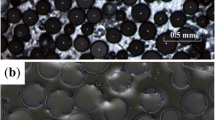Abstract
In this study a general bead-spring model is used for predicting some rheological properties of a cubic bead-spring structure of arbitrary size immersed in a Newtonian solvent. The topology of this bead-spring structure is based upon the well-known cubic crystals (SC, BCC or FCC) and it consists of equal Hookean springs and beads with equal friction coefficients, while hydrodynamic interaction is not included. An appropriate combination of the equations of motion, the expression for the stress tensor and the equation of continuity leads to an explicit constitutive equation with three sets of relaxation times belonging to the three types of bead-spring cubes (SC, BCC or FCC). For small-amplitude oscillatory shear flow it is found that the three relaxation spectra, which are significantly different, result in dynamic moduli which differ mainly in one aspect: the characteristic SC, BCC and FCC time scales are different. The BCC and FCC time scales can be obtained by multiplication of the SC time scale by the ratios M sc/M bcc and M sc/M fcc respectively, where M sc, M bcc and M fcc denote the number of springs in the three types of cubic bead-spring structures.
Similar content being viewed by others
References
A. I. M. Denneman and R. J. J. Jongschaap, A bead-spring model incorporating cyclic structures, non-equal springs and beads with non-equal friction coefficients. J. of Rheol.40 (1996) 589-612.
F. Harary, Graphical enumeration problems. In: F. Harary (ed.), Graph Theory and Theoretical Physics. London: Academic Press (1967) 1-41.
A. Dolan and J. Aldous, Networks and Algorithms: An Introductory Approach. Chichester: John Wiley &; Sons (1993) 544 pp.
R. A. Horn and C. R. Johnson, Topics in Matrix Analysis. Cambridge: Cambridge University Press (1991) 607 pp.
P. J. Davis, Circulant Matrices. New York: John Wiley &; Sons (1979) 250 pp.
R. B. Bird, C. F. Curtiss, R. C. Armstrong, and O. Hassager, Dynamics of Polymeric Liquids: Kinetic Theory (vol. 2 ). New York: Wiley-Interscience (second ed., 1987) 437 pp.
P. E. Rouse, Jr., A theory of the linear viscoelastic properties of dilute solutions of coiling polymers. J. of Chem. Phys.21 (1953) 1272-1280.
H. Kramers, Het gedrag van macromoleculen in een stromende vloeistof. Physica11 (1944) 1-19.
B. van der Vorst, E. M. Toose, D. van den Ende, R. J. J. Jongschaap, and J. Mellema, Generalized Rouse model for a dilute solution of clustered polymers. Rheologica Acta34 (1995) 274-280.
R. L. Sammler and J. L. Schrag, Bead-Spring Model Predictions of Solution Dynamics for Flexible Homopolymers Incorporating Long-Chain Branches and/or Rings. ( Tech. Rep. 113 ). Wisconsin-Madison: Rheology Research Center (1987) 57 pp.
R. L. Sammler and J. L. Schrag, Bead-spring model predictions of solution dynamics for flexible homopolymers incorporating long-chain branches and/or rings. Macromolecules21 (1988) 1132-1140.
R. L. Sammler and J. L. Schrag, Predictions of the ability of solution dynamics experiments to characterize long-chain structure in flexible homopolymers. Macromolecules21 (1988) 3273-3285.
Author information
Authors and Affiliations
Rights and permissions
About this article
Cite this article
Denneman, A.I.M., Jongschaap, R.J.J. & Mellema, J. Rheological Modeling with Hookean Bead-Spring Cubes (SC, BBC and FCC). Journal of Engineering Mathematics 34, 75–95 (1998). https://doi.org/10.1023/A:1004389031110
Issue Date:
DOI: https://doi.org/10.1023/A:1004389031110




